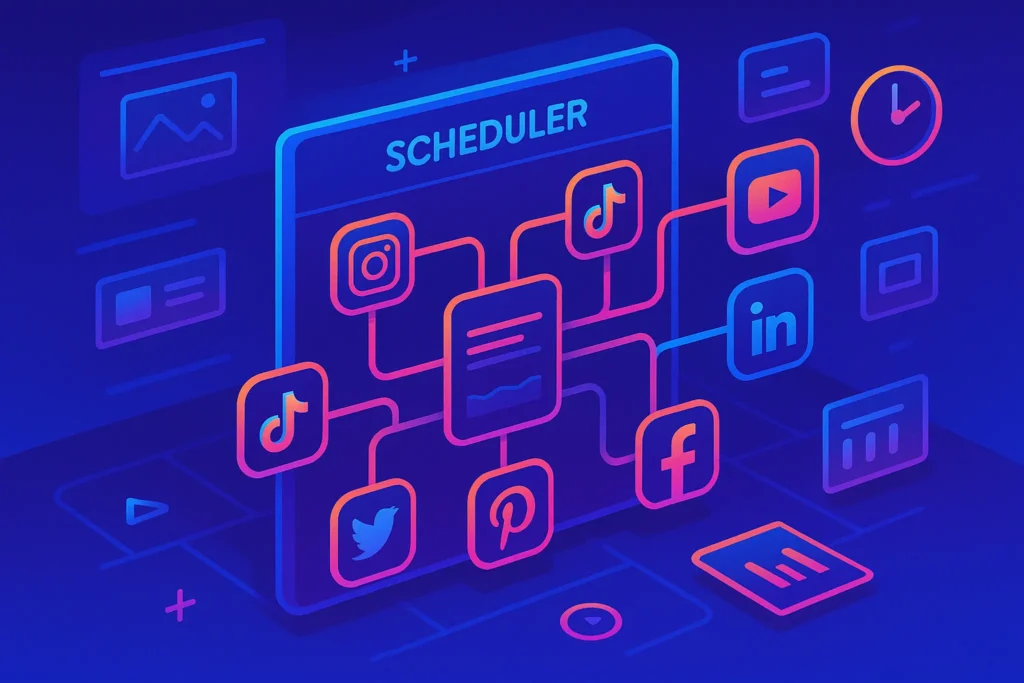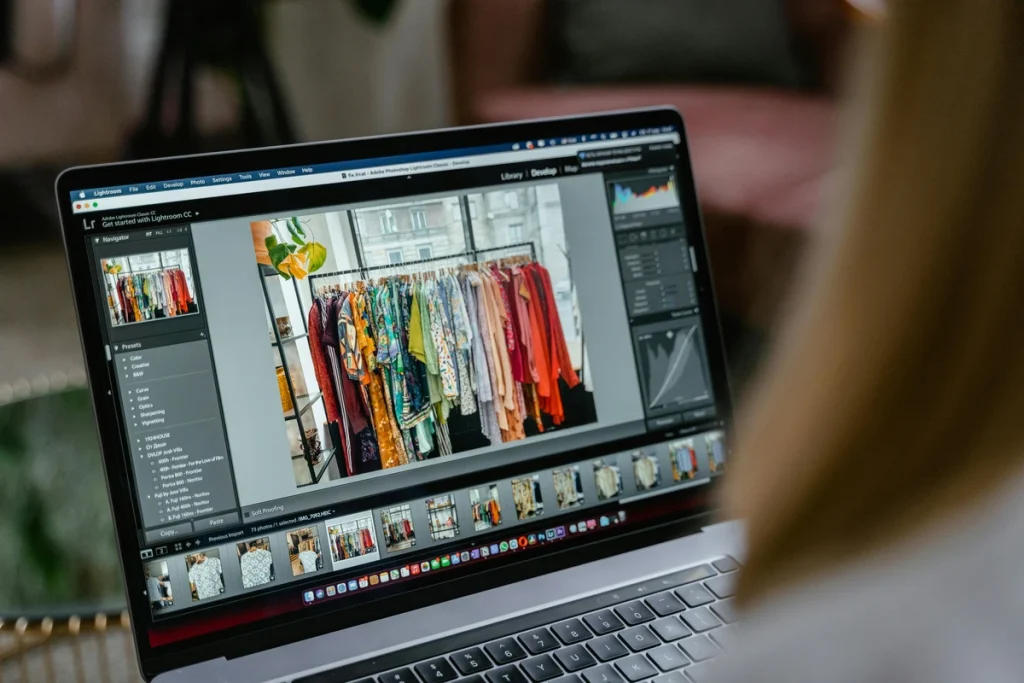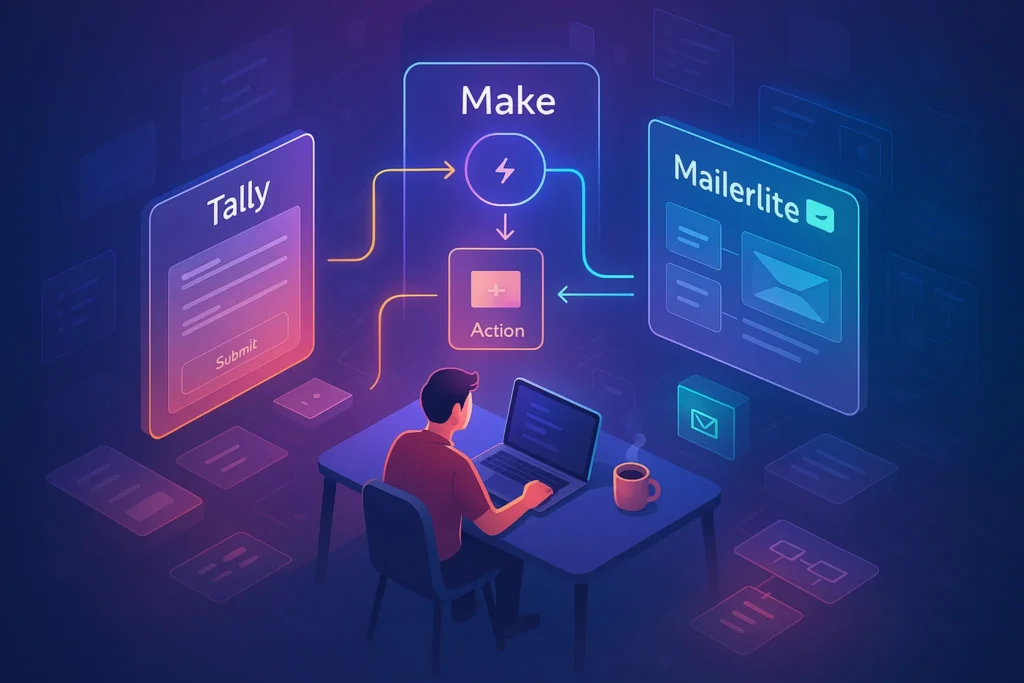🌍 Intro: Why Multi-Platform Social Media Automation is Non-Negotiable in 2025
If you’re still posting manually to each platform, you’re already behind. In today’s attention economy, timing and consistency are just as important as the content itself. Whether you’re growing a personal brand, running client accounts, or managing an eCommerce business, automating your social media scheduling isn’t just a productivity hack — it’s a survival strategy.
Consider this: The average marketer juggles 4–7 different platforms weekly, each with unique audience behaviors, peak posting times, and content formats. Without a central automation tool, you waste hours switching tabs, uploading posts, and repeating work. By integrating a cross-platform scheduling tool, you:
-
Maintain consistent posting cadence without burning out.
-
Tailor content to platform-specific formats without starting from scratch.
-
Use data-driven insights to refine strategy instead of guessing.
💬 Nerd Tip: If you’ve been relying on a single-platform scheduler like Instagram’s native planner, you might be missing the bigger picture. In 2025, audience overlap is low, so you need a hub that coordinates your message across all relevant platforms without losing authenticity.
And while we’re here — don’t forget that a smart scheduler works best with a clear content strategy. If you’re new to structured planning, our Content Calendar 101 guide is the perfect companion.
🧠 How to Choose the Right Automation Tool for Multi-Platform Scheduling
Choosing a scheduling platform is less about “what’s popular” and more about what fits your workflow. The wrong tool will either overcomplicate your process or leave you wanting features you can’t access.
Here’s the decision framework we use when evaluating scheduling tools for multi-platform use:
-
Platform Coverage – The bare minimum should cover X (Twitter), Instagram, LinkedIn, Facebook, and ideally TikTok & Pinterest.
-
Native Integrations – Does it pull comments, DMs, and engagement data into one dashboard?
-
Content Reformatting – Can it auto-adjust aspect ratios, captions, and hashtags per platform?
-
Approval Workflows – If you work in teams or with clients, this is a must-have.
-
Analytics Depth – Look for historical data, posting time optimization, and engagement segmentation.
-
AI Assistance – In 2025, tools that suggest captions, hashtags, or repurpose posts automatically can save hours.
💬 When in doubt, start with a tool that offers a free trial and integrate it with a test content calendar for one week. If it feels like it’s saving time without sacrificing quality — keep it.
If you’re curious how AI is changing the scheduling game, you might want to explore our breakdown of Top AI-Powered Social Media Scheduling Apps to Boost Engagement in 2025 — we dive deep into AI-specific features there.
✅ Tool #1: Buffer — The Veteran That Still Holds Up
Buffer has been in the automation game for over a decade, and while newer tools bring flashier AI tricks, Buffer’s reliability, intuitive UI, and affordability make it a top choice for freelancers, small businesses, and social media managers who value simplicity without losing depth.
Why it’s great for multi-platform scheduling:
Buffer supports all major platforms, including X, Instagram, LinkedIn, Facebook, Pinterest, and Mastodon. Its calendar view makes it easy to drag and drop posts, and you can fine-tune each platform’s caption and media without having to re-upload anything.
Standout features:
-
Custom Tailoring: Write one post, then tweak it for each platform without re-entering media.
-
Hashtag Manager: Save your best hashtag sets and insert them instantly.
-
Engagement Tools: Reply to comments and DMs directly inside Buffer for supported platforms.
💬 Nerd Tip: If you often post visual content like infographics or video clips, Buffer’s Canva integration is a huge time-saver. You can design inside Canva and publish straight to your Buffer queue without downloads or uploads.
🔄 Tool #2: Hootsuite — Enterprise-Level Power in One Dashboard
Hootsuite is often associated with large teams and big brands — and for good reason. It’s built for high-volume posting, multiple team roles, and deep analytics that help you refine your social media strategy based on hard data, not hunches.
Why it works across multiple platforms:
Hootsuite doesn’t just connect to the big four — it integrates with YouTube, TikTok, and even ad accounts, letting you manage organic and paid content from one place.
Standout features:
-
Bulk Scheduling: Upload hundreds of posts at once.
-
Social Listening: Track brand mentions, keywords, and competitor activity in real time.
-
Team Collaboration: Assign posts for approval, delegate replies, and manage access levels.
💬 If you’re managing multiple client accounts, create a separate content stream for each one to avoid mix-ups. You’d be surprised how common accidental cross-posting is.
If you’re transitioning from pure organic content into a paid + organic hybrid strategy, our Social Media Marketing guide offers a detailed playbook.
📬 Want to Master Multi-Platform Posting?
Join our free weekly newsletter — get expert reviews of automation tools, platform growth hacks, and real-world scheduling workflows from pro marketers.
🔐 No spam, no fluff — just actionable insights from NerdChips.
⚡ Tool #3: Later — Visual Scheduling for Visual Brands
Later started as an Instagram-first scheduling tool but has evolved into a multi-platform solution that excels at visual content planning. If your brand lives and breathes aesthetics — whether that’s photography, product shots, or short-form video — Later’s drag-and-drop visual calendar is a game changer.
Why it’s great for multi-platform scheduling:
Later integrates with Instagram, X, LinkedIn, Facebook, Pinterest, and TikTok. You can preview your Instagram grid before posts go live, which is invaluable for creators and brands that prioritize visual consistency.
Standout features:
-
Media Library: Store and tag all your assets for quick re-use.
-
Best Time to Post: AI-driven recommendations based on your audience’s active times.
-
Linkin.bio: A mini landing page for Instagram/TikTok that acts like a lightweight website.
💬 Nerd Tip: If you want to mix visual planning with data-driven posting, use Later’s analytics to compare engagement rates for carousel vs. single-image posts — you might find hidden trends.
📊 Tool #4: Sprout Social — Analytics Powerhouse with CRM Features
Sprout Social blends scheduling with in-depth analytics and basic CRM functionality, making it perfect for businesses that treat social media as a key customer touchpoint.
Why it’s great for multi-platform scheduling:
Sprout Social supports all major platforms and integrates social listening, advanced reporting, and team collaboration — ideal for agencies or larger freelance operations.
Standout features:
-
Smart Inbox: Consolidates messages from all platforms.
-
Tagging & Categorization: Organize content by campaign or theme.
-
Advanced Reporting: Create custom reports for clients or stakeholders.
💬 If you manage social accounts for multiple brands, use Sprout’s tagging system to separate campaigns. This keeps analytics clean and avoids cross-contamination of data.
🚀 Tool #5: Loomly — Calendar-First Content Planning
Loomly’s strength lies in its calendar-first workflow that’s intuitive for teams moving from spreadsheets to real automation. It’s particularly friendly for those who want light AI assistance without being overwhelmed by overly complex dashboards.
Why it’s great for multi-platform scheduling:
Loomly supports all major social platforms and offers built-in post idea suggestions based on trending topics, holidays, and industry news — perfect for keeping your calendar full.
Standout features:
-
Post Optimization Tips: Suggestions for length, hashtags, and tone.
-
Collaboration Mode: Drafts, approvals, and comment threads on each post.
-
Integration with Ad Managers: Schedule organic and paid posts in one place.
💬 Nerd Tip: If you run seasonal campaigns, Loomly’s “post idea” feature is a low-effort way to fill in content gaps with timely material.
🤖 Tool #6: SocialBee — Automation + Evergreen Content
SocialBee takes automation further with content categories and evergreen recycling, so your best-performing posts keep working for you without constant manual input.
Why it’s great for multi-platform scheduling:
SocialBee supports X, Instagram, LinkedIn, Facebook, TikTok, Pinterest, and Google Business Profile. You can create content buckets (e.g., tips, promotions, testimonials) and let the system rotate them automatically.
Standout features:
-
Evergreen Recycling: Posts get reshared on a schedule you set.
-
Content Variations: Multiple caption versions per post to avoid repetition.
-
Concierge Services: Outsource content creation and scheduling to their team.
💬 For personal brands, creating a “value tips” evergreen category ensures you always appear helpful, even during weeks you’re too busy to create new content.
🎥 Tool #7: Metricool — Analytics-Driven Scheduling
Metricool blends content scheduling with performance tracking across social media and advertising platforms. It’s ideal for creators and marketers who want side-by-side analysis of organic and paid efforts.
Why it’s great for multi-platform scheduling:
Metricool supports all major platforms, plus integrates with Google Ads and Facebook Ads. The side-by-side calendar lets you see when your ad spend overlaps with organic posts for better synergy.
Standout features:
-
Real-Time Analytics: Track engagement as it happens.
-
Competitor Analysis: See what’s working for others in your niche.
-
Unified Dashboard: Social + paid + web analytics in one view.
💬 Nerd Tip: Use Metricool’s competitor analysis to identify posting gaps — times when your competitors are quiet but your audience is active.
Mini-Comparison Table: Tool Strengths at a Glance
| Tool | Best For | Key Strength | Pricing Range |
|---|---|---|---|
| Buffer | Freelancers & Small Businesses | Simple, intuitive scheduling | Free – $6/mo |
| Later | Visual Brands & Creators | Instagram-first visuals | Free – $25/mo |
| SocialBee | Agencies & Consultants | Content categorization | $29 – $79/mo |
| Sprout Social | Enterprises & Large Teams | Deep analytics & collaboration | $249+/mo |
| Metricool | Data-driven marketers | Multi-platform analytics | Free – $29/mo |
| Loomly | Brand-focused teams | Workflow collaboration | $26 – $99/mo |
Workflow Example: From Idea to Multi-Platform Post
Example Workflow:
Imagine you run a travel blog and want to share a “Top 5 Beaches” post.
Draft content in Notion, including captions for Instagram, X, and LinkedIn.
Upload to Later for Instagram scheduling (visual grid preview ensures perfect layout).
Push same content to Buffer for X and LinkedIn but tweak captions for each platform.
Use Metricool to track performance across all channels after 48 hours.
This keeps your brand voice consistent while still respecting each platform’s culture.
🎯 Best Practices for Multi-Platform Social Media Automation
While the tools are powerful, automation can backfire if misused. Here’s how to automate without losing authenticity:
-
Avoid Blind Cross-Posting: Tailor captions, hashtags, and visuals for each platform.
-
Engage Manually: Automation should handle posting, not replying. Spend time responding to comments and DMs.
-
Use Analytics: Schedule based on audience activity, not generic “best time to post” charts.
-
Mix Evergreen & Fresh Content: Balance re-posted high performers with timely updates.
-
Review Quarterly: Replace underperforming evergreen content and refresh your hashtag strategy.
For deeper insights into structuring your calendar effectively, check our Content Calendar 101 breakdown.
Common Mistakes to Avoid in Social Media Automation
❌ Posting Identical Captions Everywhere
Each platform has its own culture — a LinkedIn post that works well may flop on Instagram.
❌ Over-Automation Without Engagement
Automation should handle posting, not conversations. Reply to comments and DMs manually.
❌ Ignoring Platform-Specific Formats
Stories, carousels, Reels, and native polls drive engagement. Automation shouldn’t erase creativity.
Tool Stack Recommendation Based on Budget
💡 Budget-Friendly Stack: Buffer (Free) + Metricool (Free) — For solo creators starting out.
⚖️ Balanced Stack: Later ($25/mo) + SocialBee ($29/mo) — For small businesses balancing visuals & multi-platform posting.
🚀 Pro/Agency Stack: Sprout Social ($249+/mo) + Loomly ($26/mo) — For teams managing multiple brands with advanced analytics.
Engagement Boost Tips
-
Ask one engaging question at the end of every post.
-
Share one piece of user-generated content per week to build trust.
-
Tag at least 2 relevant accounts in your post to expand reach.
-
Use platform-native features like polls, Q&A, and stickers for better visibility.
🧠 Nerd Verdict
In 2025, the best social media schedulers are less about “posting” and more about “orchestrating” your entire content strategy.
For solopreneurs and freelancers, tools like Buffer and Later keep things simple yet powerful. For agencies and teams, Hootsuite, Sprout Social, or Loomly offer depth and collaboration.
The real power comes when you stop thinking of automation as a shortcut and start using it as a strategic amplifier.
❓ FAQ: Nerds Ask, We Answer
💬 Would You Bite?
If you had a tool that could schedule across every platform, optimize posting times, and recycle your best content, how much extra time would that free up in your week?
Which of these tools would you try first? Drop your thoughts below — your answer might inspire our next deep-dive. 👇



